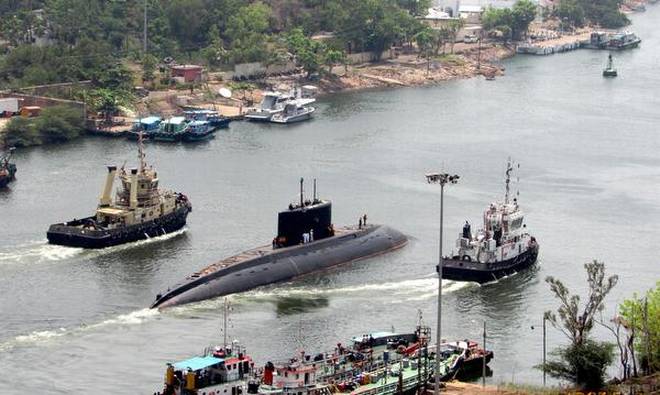
On December 8, 1967, when Commander K.S. Subramanian read out the commissioning warrant in freezing -15 degree Celsius at Vladivostok, submarine base in Russia then USSR, little did he know that he was heralding a force that would one day be a nuclear force and will complete the nuclear triad for the country. Cdr Subramanian commanded the first submarine of the Indian Navy INS Kalvari.
The submarine arm or the silent arm of the Indian Navy is celebrating its golden jubilee this year, and in the last five decades it has grown from a couple of Foxtrot class submarines to possess the Arihant class nuclear-powered ballistic missile submarines (SSBN) to the state-of-the-art Scorpene-class submarines.
The proposal to form a submarine arm was first envisaged in 1959 and a draft plan to acquire four submarines from UK at a cost of ₹16 crore with a recurring annual cost of ₹ 2 crore was moved. But it did not materialise, and it was again moved in 1962 and the government approved the proposal. A nine- member team led by Captain B.K. Dang was sent to UK to undergo training at HMS Dolphin. But the purchase proposal did not again materialise, as India wanted to buy the Porpoise or Oberon class and the British government offered the old ‘T’ class.
It was only in 1964 that the Soviet government agreed for transfer by purchase for four ‘F’ class or Foxtrot-class submarines.
About 16 officers and over 100 sailors received training at Vladivostok and a beginning was made when Cdr. K.S. Subramanian sailed into the Visakhapatnam harbour, braving 16,000 km of rough sea from Riga to Visakhapatnam, on June 6, 1968.
The submarine arm of the Indian Navy came into operation at Visakhapatnam with the then Chief of Naval Staff Admiral A.K. Chatterjee laying the foundation stone for the submarine base.
The silent arm grew with the induction of four more Foxtrot-class submarines such as INS Khanderi, Karanj and Kursura. All the four constituted the 8th Submarine Squadron and have played a key role during the 1970-71 Indo-Pak war. Today, all have been decommissioned and INS Kursura is transformed into a submarine museum and stands on Visakhapatnam beach.
The first full-fledged submarine base had come into existence in the shape of INS Virbahu on May 19, 1971 at Visakhapatnam.
The force grew with the acquisition of four more Foxtrot-class submarines from the then Soviet Union. INS Vela, Vagir, Vagli and Vaghsheer formed the formidable 9th Squadron with the base at Bombay now Mumbai.
From the Foxtrot class, the navy graduated to procure and produce the German-based HDW 1500 class or also called as the SSKs attack submarines, in mid 1980s. Referred to as the Shishumar class, four of them Shishumar, Shankush, Shalki and Shankul formed the 10th Squadron of the arm, based in Mumbai.
Keeping the tempo up, India negotiated with Russia to procure the Kilo-class or the Sindhughosh-class attack submarines. Equipped with the 3M-54 Klub (SS-N-27) anti-ship cruise missiles with a range of 220 km, for the first time India was on the offensive side of submarine warfare.
While Sindhughosh, Sindhudhvaj, Sindhuraj, Sindhuvir , Sindhuratna and Sindhurakshak (exploded and sank in Mumbai harbour on14 August 2013) were based in Mumbai to form the 12th Squadron. Sindhukesari, Sindhukriti, Sindhuvijay and Sindhurashtra were based in Visakhapatnam to form the 11th Squadron.
Nuclear era
The submarine arm entering the nuclear era began with the leasing of INS Chakra an Akula-class nuclear-powered attack submarine (SSN) from Russia in 1988 and it was based in Visakhapatnam.
Sources in the navy said Chakra was taken on lease to train officers and men with the futuristic idea to build its own nuclear fleet. After the lease of INS Chakra expired, a second Akula Class nuclear submarine INS Chakra II was taken on lease from Russia in 2012.
India built its first nuclear submarine INS Arihant under the Advanced Technology Vessel project at the Ship Building Centre in Visakhapatnam.
INS Arihant the first of the expected five in the Arihant-class is indigenously built with Akula-class technology.
Completing a full 50 years cycle, the Scorpène-class submarine is now being built for the Indian Navy at Mazagon Dock in Mumbai with French design, and they are named after the Kalvari class. The subs will be named after the first batch that served the navy such as Kalvari, Khanderi and Karanj.
President to present colours
As part of the celebrations, President Ram Nath Kovind will be awarding Presidential Colours to the Submarine Arm of the Indian Navy at a Colour Presentation ceremony to be held in Visakhapatnam on December 8.
source: http://www.thehindu.com / The Hindu / Home> News> Visakhapatnam / by Sumit Bhattacharjee / Visakhapatnam – December 07th, 2017